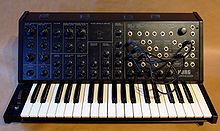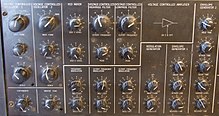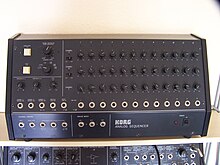Korg MS-20
The Korg MS-20 is a monophonic analog synthesizer , which was built by the company KORG from 1978 to 1983. It is one of the most legendary synthesizers of that time and is still used by musicians today and traded as a collector's item.
| Korg MS-20 |
|---|
| classification |
| Synthesizer , keyboard instrument |
| Original price |
| approx. 1490 DM |
| number of pieces produced |
| approx. 20,000 |
construction
In addition to the MS-10, the MS-20, which was built from 1978, was the most important representative of Korg's MS series. Thanks to its semi-modular structure and patchable signal paths, it offers a high degree of flexibility. In contrast to the polyphonic synthesizers of the PS series introduced a year earlier, the MS synthesizers impressed with their smaller size. While only an estimated 100 of the PS models (PS-3300) were built, the MS-20 was able to be sold around 20,000 times during its production time.
The MS-20 has a keyboard with 37 keys, which corresponds to three octaves . Hitting the keys corresponds to different voltages with which the VCOs of the synthesis unit were tuned. The internal signals are divided into audio signals and control signals. The latter map their range of values over a voltage of −5 to +5 volts.
The standard sound synthesis (without patch cable) is based on two VCOs in the MS-20, which can be operated in triangle , sawtooth , pulse and noise modes . There is also a noise generator in the pink noise and white noise modes . The second VCO can also be modulated by the first VCO via ring modulation. The signals from the two VCOs are then mixed by the mixer before the signal is first passed through a high-pass filter and then through a low-pass filter .
This signal flow chain is supplemented by two envelopes , of which the first ( EG1 ) is used as a delay attack release (DAR) and the second ( EG2 ) as an attack-decay-sustain-release envelope ( ADSR ) with hold option . A curiosity is that when the filter corner frequency is influenced by the second envelope generator, the effect of the sustain level is inverted (i.e.: high sustain level = closed filter, low sustain level = open filter; it should actually be the other way around). The VCOs and filters are also modulated by an LFO called a Modulation Generator (MG) .
Outside the specified signal path, there is a sample and hold block and a block to route external signals through a separate filter section and to derive control voltage and trigger from them. A wheel controller to the left of the keyboard can also be used to generate control voltages.
Comparable synthesizers
Korg MS-10
The Korg MS-10 was the entry-level model in the MS series. In contrast to the MS-20, it has 32 instead of 37 keys. It also has only one VCO, which can generate the waveforms triangle, sawtooth, noise and pulse wave in the foot positions from 4 'to 32'. Like the MS-20, it has an LFO with the waveforms sawtooth (ascending and descending), which are continuously adjustable via a triangle (in the middle). It only had a low-pass filter, i.e. not the high-pass filter as in the MS-20 and only a HADSR envelope, as well as a simplified external signal input without a filter, i. H. without the possibility of tapping the control voltages from external audio signals (number of items produced: approx. 10,000)
Korg VC-10
Although the Vocoder VC-10 does not belong directly to the edition of the MS synthesizer, it came with the same design. The case was roughly the same as that of the Ms-10. In addition to its main purpose, the Vocoder VC-10 was used to play microphone voices in chords and to generate the typical robot sound, as well as to play the audio signals of the MS synthesizer quasi polyphonically.
Korg MS-50
The Korg MS-50 is a keyboardless expander .
ARP 2600
see ARP 2600
Accessories and conversions
The analog sequencer Korg SQ-10
The Korg SQ-10 was developed as an analog step sequencer for the Korg synthesizers of the MS series, but can also be used with other voltage-controlled synthesizers. It has 12 steps, for each of which three control voltages (channels A, B and C) can be set. Channels A and B can be switched in series so that the SQ-10 then has 24 steps.
The MS-20 today
Myth MS-20
With the beginning of the retro wave in analog synthesizers in the early 1990s, the MS-20 also began to rise again in popularity. While synthesizers like the Roland TB-303 were particularly popular in the techno and acid house scene, the MS-20 was also popular in the more experimental music scene due to its "dirty" sounds . The main reason for this sound behavior are the series-connected filters, which do not cause the typical whistling, but rather a “screeching” when they resonate. The technical cause of this sound coloration also lies in the use of distorting diodes and their non-linearity. Thanks to this feature, many MS-20s are still in use today, especially in the industrial and noise scene.
The MS-20 as software
- Korg Legacy Collection
In addition to the MS-20, the Polysix and the Wavestation are simulated in software. In addition, a version of the MS-20 that is about 20 percent smaller is supplied as a USB input device with all controls and buttons. The simulation of the MS-20 has been expanded to include 32-note polyphony and a unison mode.
- Korg Legacy Collection Analog Edition 2007
Since the beginning of 2007, the emulation of the MS-20 has been available in a package with the Polysix and the newly added Mono / Poly. The MS-20 hardware controller has been saved, which is reflected in a significantly lower purchase price compared to the old Legacy Collection.
- Korg DS-10 for Nintendo DS
There is a synthesizer for the Nintendo DS that is based on MS sound generation, but on the one hand it has additional properties (step sequencer, KAOSS-PAD, effects, etc.), but on the other hand it does not have all the components of an MS-20. (missing pulse width modulation, no sample and hold etc.).
- Korg iMS-20 for the iPad
The iMS-20 has been available since November 9, 2010. It expands the functionality of the original device with a pattern composer, two Kaoss pads, various effects, mixers and six drum tracks. The drum sounds can be built and configured via an easily adapted MS-20 surface. The iMS-20 is therefore suitable for arranging simple songs with up to seven tracks. With the help of the Camera Connection Kit and a connected powered USB hub, the MS-20 Legacy Controller can be used with the iMS-20 software on the ipad.
The MS-20 mini
At the NAMM Show in January 2013, Korg introduced the MS-20 mini. This is an analog synthesizer that is largely the same as its model, but is only 86% of its size and its electronics, in contrast to the original model, are manufactured in SMD construction .
The MS-20 and the MS-20M as a kit
At the NAMM 2015, Korg surprisingly presented not only the reissue of a smaller ARP Odyssey but also a desktop version of the MS20 which provides FM, sync and a patch socket for controlling the pulse width modulation. So far it has only been supplied in a limited number of 1000 pieces together with the SQ1 sequencer as a kit, in which the user himself has to screw the finished circuit boards into the housing. In addition, it now contains the two well-known filter circuits, the older one based on the IC35 and the newer, less noisy version, which also produces a more tamed but higher quality sound. This is the first MS-20 that can handle frequency modulation and oscillator synchronization at all, but remains a pseudo-modular synthesizer, because you have no access to the audio signal path and the individual oscillators. Like the MS-20M, the MS-20 kit is also available in a limited edition for self-assembly. This is the full-size MS-20 with USB and MIDI.
Artist
The following major artists have used the MS-20 or are still using it: Air , Apoptygma Berzerk , Beborn Beton , DAF , Liaisons Dangereuses , Depeche Mode , Aphex Twin , Jean Michel Jarre , Portishead , The Prodigy , OMD , Einstürzende Neubauten , KMFDM , Die Krupps , Mittageisen , Front 242 , Laibach , Digitalism , The Sound of Arrows , Röyksopp , Alphaville , Daft Punk and many more.
Web links
- Description at vintagesynth.com
- MS-20 User Manual (PDF; 4 MB)
- Original vs. New edition of the Korg MS-20 mini in the test
- Vintage Synth Special - Korg MS-20
- - MS-20M in the Sequencer.de synthesizer database with a picture of the kit that has not yet been assembled
Individual evidence
- ↑ Timothy E. Stinchcombe: A Study of the Korg MS10 & MS20 Filters. In: timstinchcombe.co.uk. August 30, 2006, accessed August 10, 2020 .





